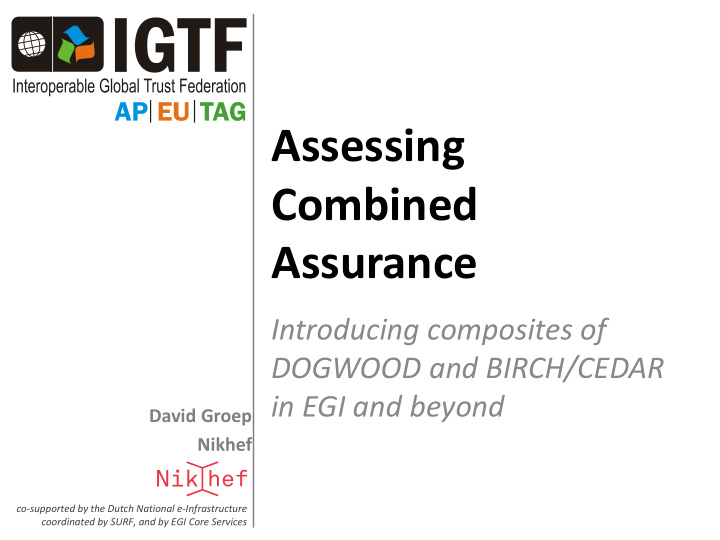



Assessing Combined Assurance Introducing composites of DOGWOOD and BIRCH/CEDAR in EGI and beyond David Groep Nikhef co-supported by the Dutch National e-Infrastructure coordinated by SURF, and by EGI Core Services
EGI Combined Assurance use case • IOTA AP assurance level ‘DOGWOOD’ is different, but remainder of the assurance can be taken up somebody else – the user community or the registrar for the Access Platform Identity elements • Only thing you get is an opaque ID • identifier management • re-binding and revocation • Stepping up to adequate assurance: • binding to entities – Real names from pseudonyms • traceability of entities • emergency communications – Enrolling users in a community – Keeping audit records • regular communications – Auditability and tracing • ‘rich’ attribute assertions – Incident response • correlating identifiers • access control Evolving the EGI Trust Fabric - Bari 2015
The wLCG IOTA CA by-pass ‘ lcg- CA’ For EGI-only sites nothing changed or explicit For EGI sites also under wLCG policy and installed post-EGEE: configuration just install both policy packages “ egi- core” and “ lcg ” ca-policy-egi-core IGTF Classic IGTF MICS IGTF SLCS ca-AEGIS … ca-TCS … ca-DFN-AAI … ca-policy-lcg IGTF Classic IGTF MICS IGTF SLCS ca-CERN- ca-AEGIS … ca-TCS … ca-DFN-AAI … LCG-IOTA Evolving the EGI Trust Fabric - Bari 2015
Project MinE (ALS) use case • Access traditional global grid resources from the CLI • By users that have no PKIX experience but are all properly vetted and registered (in the SURFsara CUA) • Case comparable to LHC VOs (and to ELIXIR) • Give access based on DOGWOOD CUA ID – and prepopulate a VOMS server based on CUA details Leveraging the IGTF registration network for research 25 September 2017
Thanks to Mischa Sallé INTERLUDE Leveraging the IGTF registration network for research 25 September 2017
A proxy from the TTS: the ad-hoc way additional info: Mischa Sallé, msalle@nikhef.nl Leveraging the IGTF registration network for research 25 September 2017
A one-time URL giving a shell script additional info: Mischa Sallé, msalle@nikhef.nl Leveraging the IGTF registration network for research 25 September 2017
Register your ssh public key – like in gitlab, sourceforge, &c additional info: Mischa Sallé, msalle@nikhef.nl Leveraging the IGTF registration network for research 25 September 2017
Hiding PKIX – just like KRB • Implicit retrieval of proxies using ssh-agent • Resulting proxies can decorated with VOMS without need for passphrases or other credentials additional info: Mischa Sallé, msalle@nikhef.nl • Predictable RCauth subject naming (USR) allows pre-registering in VOMS, COmanage, &c Leveraging the IGTF registration network for research 25 September 2017
Beyond DOGWOOD (CERN IOTA, RCauth, CILogon Basic) • Old model: CERN STS tight VO binding model – With the EGI and WLCG specific exception • EGI combined assurance model – Make assurance combination part of service AuthZ – Implemented by major AuthZ frameworks: Argus (1.7.1+), LCMAPS, dCache (3.1+) – Configuration shipped via EGI and WLCG • But: which ‘other’ assurance providers qualify? Leveraging the IGTF registration network for research 25 September 2017
Specific Delegated Responsibilities Need for proper traceability does not go away, so … • who holds that information need not only be a traditional CA • but can be another entity with similarly rigorous processes Some communities have an existing registration system that is very robust • PRACE – in-person links at the home sites • XSEDE – NSF grant approval process • wLCG – CERN Users Office and HR Database Evolving the EGI Trust Fabric - Bari 2015
Distributed Responsibilities I: Trusted Third Party Evolving the EGI Trust Fabric - Bari 2015
Distributed Responsibilities II: Collaborative Assurance & Traceability Evolving the EGI Trust Fabric - Bari 2015
IOTA in the EGI context EGI – by design - supports loose and flexible user collaboration • 300+ communities • Many established ‘bottom - up’ with fairly light -weight processes • Membership management policy* is deliberately light-weight • Most VO managers rely on naming in credentials to enroll colleagues Only a few VOs are ‘special’ • LHC VOs: enrolment is based on the users’ entry in a special (CERN - managed) HR database, based on a separate face-to-face vetting process and eligibility checks, including government photo ID + institutional attestations • Only properly registered and active people can be listed in VOMS Leveraging the IGTF registration network for research 25 September 2017
Developing an assessment framework Leveraging the IGTF registration network for research 25 September 2017
The need for guidance Leveraging the IGTF registration network for research 25 September 2017
Assessment Matrix • Mapping for PKIX/RFC3647 is trivial • How to apply out BIRCH/CEDAR guidance to community registries? https://wiki.eugridpma.org/Main/AssuranceAssessment • Relevant for COmanage & VOMS communities, but maybe wider? Leveraging the IGTF registration network for research 25 September 2017
Discussion! BUILDING A GLOBAL TRUST FABRIC Leveraging the IGTF registration network for research
Recommend
More recommend